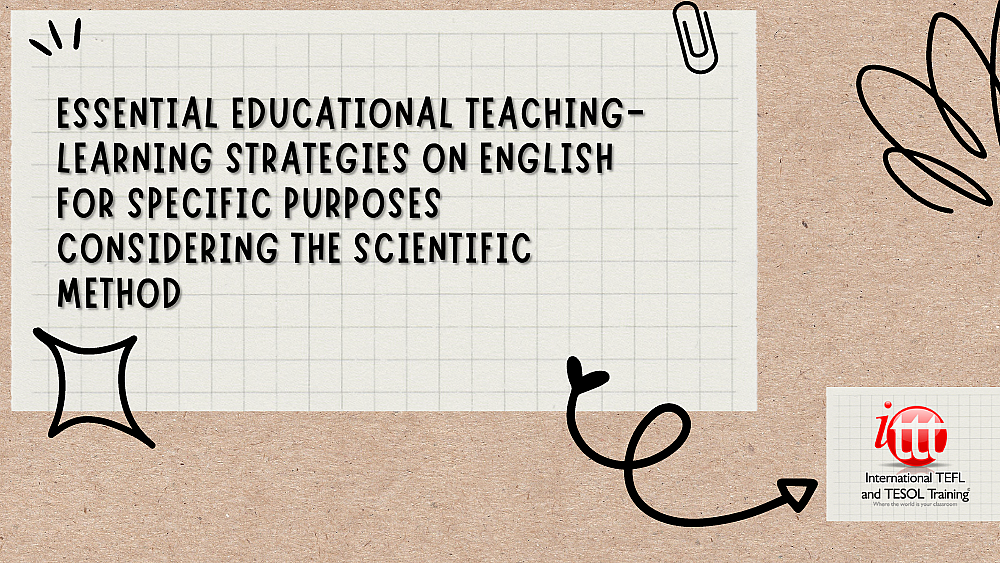Essential Educational Teaching-Learning Strategies on English for Specific Purposes considering the Scientific Method

By Estefany Garduño
Table of Contents
What is the Teaching-Learning process?
Learning is a cognitive ability that allows an individual to observe and imitate the way ofcarrying out an action or solving a problem with the mechanism analysed. Cognitive skills are those mental operations and analyses that the brain carries out to process information and be able to make decisions during the teaching process. Through imitation or repetitive practice, the analysis of different factors and the elements involved allows the individual to execute the skill learned in the field or everyday situations, whether it is daily life or professional life. In this article, you will identify essential Educational Teaching-Learning Strategies on English for Specific Purposes for individuals in their learning stage, keeping in mind the objectives that need to be achieved through the teaching methods, the scope that is intended, limitations that may arise or restrictions, as well as the evaluation of effectiveness after being applied.
How could I identify the Teaching Strategies in my ESP class?
Three Essential Educational Teaching-Learning levels to develop strategies for ESP class are established:1. Pre-instructional level. Presentation of objectives, topics, and activities to capture concepts and procedures to students and alumni.2. Co-instructional level. Guide during the explanation, development, and practice of learningwith students and alumni.3. Post-instructional level. Execution of the acquired procedures and techniques on application cases where they must be able to identify the learned factors, as well as those that are new, and solve those that are new through cognitive analysis and innovate in a solution, which will be part of new learning.
Taking into account the levels described above, several types of English Teaching Strategies for ESP are analysis of illustrations, concept maps, flow charts, application of the scientific method to solve real professional cases (talking about ESP areas), summaries, essays, analogies, preparation of explanatory videos, podcast, blog writing, post preparation, etc., the latter making use of the technological tools that are already within everyone's reach.
What do I have to consider to develop Educational English Teaching-Learning Strategies for my ESP class?
The current trend in Educational English Teaching-Learning Strategies of ESP involves animportant consideration of technological advances, social and business responsibility,environmental sustainability, and emotional intelligence given in a region, state and/or nation for the generation of said mechanisms. At the same time, current educational models are considered such as sociocultural theory, implemented by Vygotsky in 1979; the theory of constructivism, by Piaget in 1972; the theory of teaching for understanding by Perkins and Stone in 1999, among others, which continued to be the basis, however, we must go beyond these through innovation.
A clear example of the application of teaching strategies for ESP with the three levels ofdevelopment is the application of the scientific method, which consists of the following stages:1. Observation.2. Asking questions.3. Hypothesis.4. Development of an experimental design.5. Data collection.6. Data analysis.7. Hypothesis testing.8. Acceptance or rejection of data.9. New hypothesis approach in case of data rejection.10. Implementation of a theory, law or argued procedure, in case of data acceptance.
For the students to know what the scientific method consists of and how to apply it, they must be given the conceptual bases and foundations of its existence at a pre-instructional level, so that they identify the objective of its application. Once this is understood, an exercise can be shared with them so that, in a guided analysis, they will begin to present each stage of the scientific method, through a co-instructional level (Vázquez, 2016). Finally, by repeating several exercises guided by the specialist, they can be given an application case (in scientific articles or a real case that is open) so that they can make their approach to applying the scientific method technique.The latter would be at the post-instructional level, where they may or may not require the support of the expert who has taught them.
Conclusion
Teaching strategies for meaningful learning can vary depending on the teacher's experience, how students and alumni develop due to their level of understanding on ESP and of course the level of immersion that the teacher applies during class. It is important to recognize that the application of the scientific method is specifically from the analysis of a scientific case, so the students will apply the grammar and vocabulary of the English language, besides learning skills to solve problems in the specific area of the ESP lesson.
*The opinions expressed by the author are solely their own and do not necessarily represent the views of ITTT or the training programs offered. The information shared is intended for informational purposes only. Readers are encouraged to exercise their own judgement and discretion.
References:Novak, J. D. (2010). Learning, creating, and using knowledge: Concept maps as facilitative tools in schools and corporations (Second edition). New York: Routledge.
Vázquez, J. (2016). El trabajo colaborativo y la socioformación: un camino hacia el conocimiento complejo. Revista Educación y Humanismo.
Are you ready to teach English abroad or online?APPLY NOW & GET CERTIFIED TO TEACH ENGLISH ABROAD!Email



